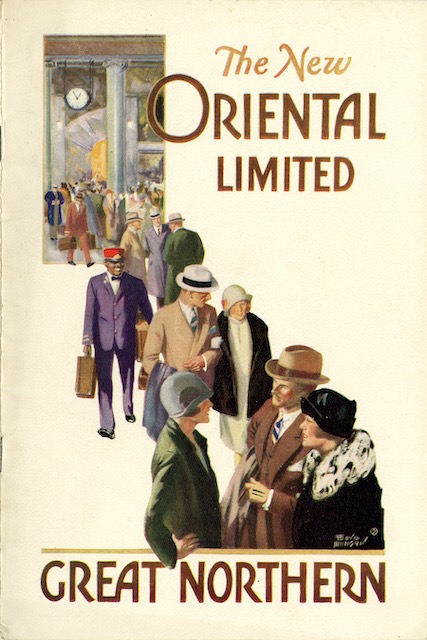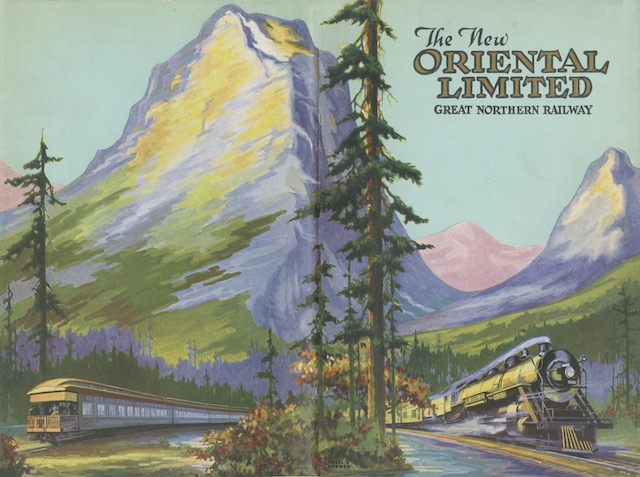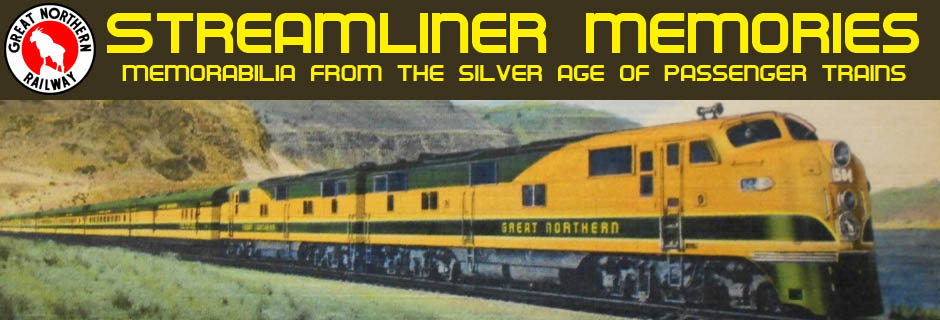As we’ve seen in the last few days, Great Northern engaged in a major public relations campaign when it inaugurated the new Oriental Limited, a nearly-all-steel train, in 1924. We’ve previously seen two booklets issued about this train, and this one is a third. Although I’ve nominally dated them all from 1924, the GN continued to use the phrase, “New Oriental Limited” for several years, and it is unlikely that it would have issued all three booklets in the same year.
 Click image to download a 16.8-MB PDF of this 30-page booklet whose cover is by Floyd Wilson.
Click image to download a 16.8-MB PDF of this 30-page booklet whose cover is by Floyd Wilson.
The first booklet I presented has a painting of the train’s rear platform in a station, probably Minneapolis. The painting is signed “Conaughy,” which would be Clarence W. Conaughy (1885-1965), an illustrator who taught at the Minnesota Institute of Arts. The interior of the booklet is mainly text but with a number of mostly small, somewhat dark and muddy black-and-white photos showing the interiors and exteriors of the train.

Click image to download an 18.4-MB PDF of this brochure with a cover by Clarence Conaughy.
The second booklet I’ve shown has a beautiful wrap-around cover painting showing the train near Mt. Index, Washington. The painting is signed Hazel E. (for Eunice) Brewer (1896-1991), a Minnesota artist who later married and became Hazel Wilson. Inside the booklet are numerous black-and-white photos that are much crisper and clearer than in the previous booklet.

Click image to download a 6.9-MB PDF of this 30-page booklet. Click here to download a 6.2-MB PDF showing the wraparound cover painted by Hazel E. Brewer.
Today’s booklet uses most of the same black-and-white photos and text as the Hazel Brewer booklet. The cover illustration is painted by Floyd Wilson (1888-1945). A Portland art dealer named Mark Humpal has compiled a detailed biography of Wilson.
Although no relation, as far as I know, to Hazel Wilson’s husband, Floyd Wilson was a Minnesota native who studied at the Minneapolis School of Fine Arts. After graduating, he spent most of his career either on the West Coast or in New York. In the 1910s, his art was exhibited at a Society of Oregon Artists show, the Portland Art Museum, San Francisco’s Panama-Pacific Exposition, and in Minneapolis, among other places. He also did cover illustrations for a labor union paper called Blast.
In 1921, he married Dorothy Gilbert, an artist he had met in Portland, and they settled in Woodstock New York. Sadly, in 1945 he was hospitalized and, after a brief stay, died of “manic-depressive psychosis.” This sounds like a polite way of saying he committed suicide. He was known to be shy and didn’t like to talk about his art, but otherwise the information known about him doesn’t indicate he had been particularly depressed.
None of these booklets are dated, but the booklet with the Conaughy cover is likely the first. The poor-quality photos probably represent a rush to get the booklet into print between the time the cars were delivered from Pullman and when the train was put on exhibition.
One of the photos that is different in the Wilson and Brewer booklets shows the train’s observation platform on page 6 (starting with the cover being page 1). In the Brewer booklet, the train has a rear drumhead that says “Oriental Limited” with the goat logo. In the Wilson booklet, the rear drumhead just says “Oriental Limited” and a close look reveals that this has been “photoshopped” over the rear gate of the platform.
This indicates that the Floyd Wilson booklet came before the Hazel Brewer booklet. This suggests that either the Wilson booklet came out in 1925 and the Brewer booklet in 1926, or that the Conaughy book came out in early 1924, the Wilson book in later 1924, and the Brewer book in 1925. Maybe I’ll be able to find out for sure on my next visit to the Minnesota History Center.
All three paintings manage to convey a strong sense of motion. But the motion of the Conaughy cover is that of people eagerly boarding a train and the motion of the Wilson cover is that of satisfied passengers getting off the train. Only the Brewer cover shows the motion of the train itself.
